
Medically Reviewed by Max Parikh, M.D. NVISION Surgeon
Athlete’s Guide to Protecting Vision & Maintaining Eye Health
Home /
Last Updated:

Medically Reviewed by Max Parikh, M.D. NVISION Surgeon
Seeing a ball, puck, or another player is a vital component of playing any sport. Many athletes have exceptional visual clarity, depth perception, and reaction times.
Table of Contents
Athletes put themselves in unique situations with specific risks, depending on the sport they play. Each sport has overseeing league or organizational bodies that suggest the best types of eyewear to protect against ultraviolet light, impact, or blunt damage. They even suggest which types of eyewear can improve an athlete’s vision.
Athletes excel in certain visual areas aside from just clear vision, but they face unique risks like damage from balls or other players. Depending on your specific needs as an athlete, you can wear glasses, use contact lenses, or even get LASIK.
Your visual health is an important component of your overall health. It is important to get regular eye exams to support your long-term well-being.
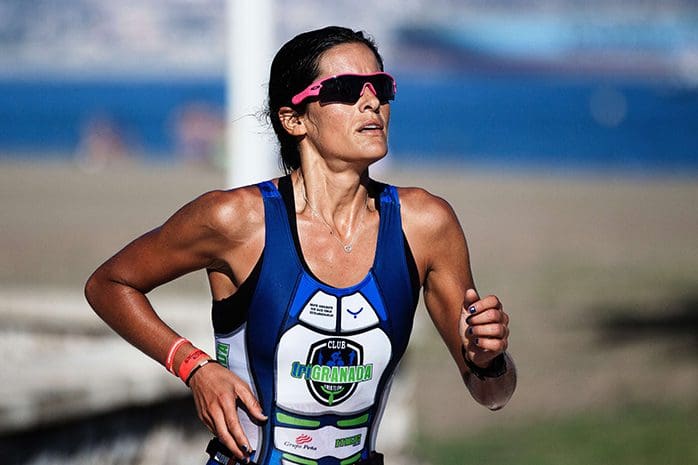
Vision & Eye Health for Athletes
Vision is one of the crucial components of playing any sport. Clarity of sight, motor skills related to vision, and speed of visual information processing are all core talents and abilities that athletes must possess.
Good vision is not just about clear vision, since refractive errors like nearsightedness, farsightedness, and astigmatism can be easily compensated for. It is about color vision, depth perception, tracking, memory, and reaction time.
You deserve clear vision. We can help.
With 135+ locations and over 2.5 million procedures performed, our board-certified eye surgeons deliver results you can trust.
Your journey to better vision starts here.
Just like other parts of your body, you can train your eyes on certain skills to improve your athleticism. While some parts of your vision are genetic or environmental, like your visual acuity or color vision, dedicated sports vision trainers can diagnose any weaknesses in an athlete’s eyesight and coach them to improving these issues. Sports vision trainers can also recommend methods of preserving athletes’ vision, like wearing special sunglasses or participating in specific visual exercises.
Many of the most skilled athletes have exceptional vision, but they do not inherently have better vision than lower-ranking sports players. However, there are lower rates of vision or eye problems among lower-tiered and higher-tiered athletes when compared to the general population. People who are less likely to have early onset vision problems, such as myopia in childhood, are more likely to participate in all kinds of sports throughout their adolescence and into adulthood.
Just like anyone else, athletes can experience vision problems. A combination of contacts or glasses with vision training can keep an athlete in the best possible condition to play.
Different Sports Require Different Vision Protection
Each different sport has league organizations that offer safety recommendations and regulations for players.
The websites of sports leagues outline the rigorous safety standards required by professional sports teams. As you see the kinds of harm players are most at risk for, you’ll begin to understand why certain rules are in place or why certain types of gear appear in one sport but not another.
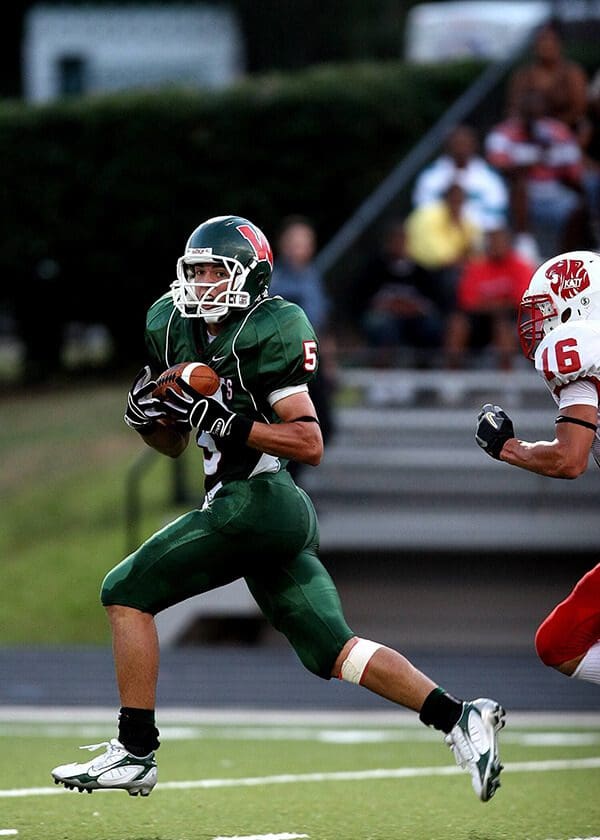
Football
This is one of the most popular sports in both the United States and Canada, where it is sometimes called gridiron football. The sport evolved from both soccer and rugby. The highest professional league for football is the National Football League (NFL).
- Dangers: The two biggest vision risks from playing football are eye injuries and concussions. Flying elbows or hands from other players, being tackled too hard, or otherwise being hit in the head can cause damage to the eye, eye socket, and visual processing areas of the brain. Ultraviolet (UV) light exposure from playing outdoors in the daylight is the second major concern. This can cause damage to the cornea and retina. It can lead to eye cancer, macular degeneration, and other forms of vision loss.
- Protection: Helmets are the best eye protection, as well as head protection, available to players. Virginia Tech rates football helmets regularly for safety, with the Schutt F7 LTD listed as the best in 2019. It is lightweight, at 5.1 pounds; has a great overall level of protection; and is the most adept at protecting against concussions. You may consider getting contact lenses instead of glasses to play football, as they allow the helmet to fit snugly around your head. Contacts also allow you totally unobstructed peripheral vision. You can also ask your optometrist about specialized glasses or eye guards. Putting black grease paint underneath the eyes is a tradition in American football, although more players use this noticeable area to display favorite images or quotes. Traditional football black, however, is designed to reduce glare from stadium lights and the sun. While it may not be the most effective option, reducing how much UV is in your vision is important. Rather than using just eye black, consider special sunglasses or a UV- and glare-protecting visor shield for your helmet.
- Prevention: Wearing safety gear is the best way to reduce the risk of injury, and this includes protecting your eyes from the sun or bright stadium lights. Finding a sports vision specialist for training on specific ways of seeing and reacting to moving objects can also improve your game. A study from 2018 reported that young athletes became better football players when they were taught to scan the field, rather than hyper-focus on the ball. This requires integrating central and peripheral vision inputs and training the body to react in specific ways. It can also reduce the risk of injurious physical impact with other players.
Baseball
Considered a great American tradition, baseball is now internationally popular, with teams from all over the world-dominating professional leagues. In the U.S., Major League Baseball (MLB) is the highest league in the sport.
Even in lower leagues, baseball is one of the toughest sports for the eyes. You have to spot a small baseball coming at you at 90 miles per hour, usually taking less than half a second to reach the plate. You need good hand-eye coordination to hit the ball, and good distance vision to catch it. Your reaction times from all positions must be good.
- Dangers: Like football players, baseball players are at risk for concussions and direct eye damage from bats or balls. Since they often play outdoors, they are exposed to UV light. They are also exposed to dirt and dust, which can increase the risk of dry eye.
- Protection: In addition to baseball helmets, up to 20 percent of players wear some form of vision correction while they play. Even players with 20/20 vision may wear contacts or glasses to get better visual acuity, toward 20/12 or even sharper. Choosing the right glasses is important. Goggles or strapped in frames will stay on your head better than standard frames, which only fit over the ears. Glasses approved by the American Society for Testing and Materials (ASTM) are specifically designed for sports like baseball. Frames with less material blocking your peripheral vision can help you see the ball, and materials like polycarbonate provide good impact and scratch resistance while also allowing for special coatings and adjustments, including high-definition (HD) sight. You can get UV-reducing clear coatings or get the same with a traditional sunglasses look. Two of the best sets include the Under Armour Igniter Polarized Multireflection Sunglasses and the Oakley Radar EV Path Sunglasses.
- Prevention: Protective gear like helmets and glasses are crucial to reducing risks to the eyes in baseball. Some vision training can also improve players’ ability to track the ball and hit or catch it. An experiment at the University of California, Riverside looked at 19 baseball players on the school’s team. They used a special vision training app 25 minutes per day, four days per week, which used Gabor patterns to help the participants focus. Over two months, players reportedly boosted their vision 30 percent. Regular eye exams are also important preventative tools. Your optometrist or ophthalmologist will review your eyes’ health history, examine your eyes and visual acuity thoroughly, and recommend courses of treatment for any problems that arise, like dry eye.
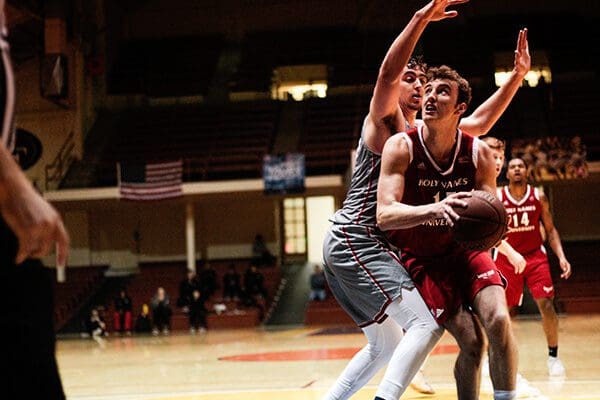
Basketball
The National Basketball Association (NBA) represents dozens of the top-level teams in the U.S. High school and college basketball is also extremely popular. As with football and baseball, athletes start young.
Unlike both players in football and baseball, basketball players do not often wear protective glasses or helmets. While they play indoors and are less likely to need protection from UV rays, there is a much higher risk of damage to the eyes and head than with some other sports.
- Dangers: There are an estimated 6,000 eye injuries in basketball every year. About 16 percent of eye injuries in children between 1990 and 2012 occurred while playing basketball. About 90 percent of sports-related eye injuries can be prevented with appropriate protective eyewear. This type of protection is not traditional in basketball, as it is for other sports.
- Protection: Polycarbonate glasses are the best protection against direct eye injuries, including in basketball. These lenses have incredible strength and resistance to damage, so if the ball or another player hits you in the face, they are much less likely to shatter. Special glasses that wrap around the head, and have straps to keep them in place, are the best option for visual protection. These are useful even if you have 20/20 or better vision. Goggles conforming to ASTM F803 are the best option for basketball players. This safety level is specific to sports, including basketball. Two of the best options for glasses include Liberty Sport F8 Morpheus III ASTM Sports Goggles and Hilco Boston Sports Goggles.
- Prevention: Safety gear and regular eye exams are the two best methods of preventing eye problems for basketball players. Since the sport is played predominantly indoors, there is less risk of sunlight or glare problems. A good pair of basketball glasses can include anti-reflective lens coating, so indoor lights are less blinding too.
Hockey
Ice hockey is one of the most popular games in North America, eclipsing field hockey, the original version of the sport. The governing body for the largest hockey teams is the National Hockey League (NHL).
This fast-paced sport combines a quickly moving puck, large sticks, and, in ice hockey, sharp skates. While hockey players routinely wear helmets, they are not often seen with other eye protection, which can make a huge difference for their future vision.
- Dangers: Even with helmets and face guards, both ice hockey and field hockey put players at high risk for eye damage. A study published in 2014 examined 8,741 NHL players who played at least one game in the past 10 seasons. There were 149 orbital eye injuries, resulting in an incidence of about 2.48 per 10,000 athlete exposures, but visor use changed during that time. It rose 32 percent between 2002 and 2003, and it rose 73 percent between 2012 and 2013, which greatly helped to lower the rate of injury. The risk was always much higher when visors were not worn. About 37 percent of the eye injuries involved being hit by the puck, and 28 percent involved being struck by a stick. Additionally, players who routinely did not wear visors were paradoxically more likely to be in fights and get hit, which increases the risk of concussion and eye damage.
- Protection: The first protective hockey visor was not invented until 1973, and it was not mandated as protective gear by the NHL until 2013. Hasbro Children’s Hospital, Boston Children’s Hospital, University of Colorado School of Medicine, and Fairfax (Virginia) County Public Schools collaborated on an examination of high school girls’ field hockey players. They found that mandated protective eyewear reduced eye injuries threefold. Wearing these visors greatly improves eye safety. Two of the best visors include the Bauer Pro Clip Straight Visor and the Under Armour Storm Straight Visor.
- Prevention: Visors are the best way to keep sticks and pucks away from your face while playing hockey. Other prevention tips include getting regular eye exams and seeking immediate health care if you are hit in the head. Concussions can impact your vision. A blow hard enough to hurt your brain might also hurt tissues in or around your eyes, like your retina.
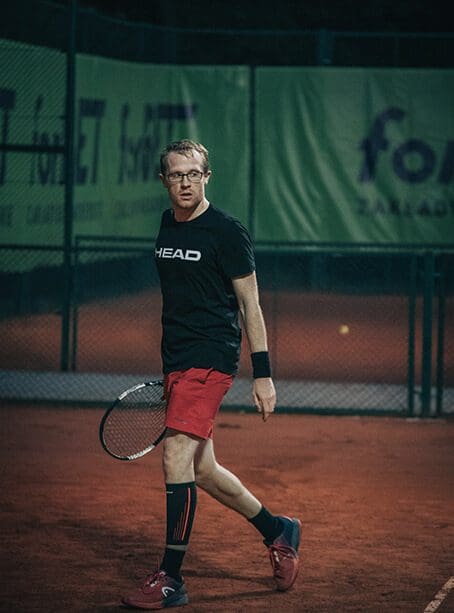
Tennis
Unlike the other sports listed, tennis is a racket sport played one-on-one (singles) or two-on-two (doubles). This is an Olympic sport that originated in Birmingham, England.
Modern tennis is typically played outside, on professional tennis courts. This outdoor exposure means players should wear protection from UV light, along with safety glasses or goggles to protect their eyes from impacts from the ball or a racket.
- Dangers: Tennis players almost never wear protective gear for their heads and eyes, including sunglasses. This must change, as the risk of impact from a ball or racket is high, and over time, damage from UV exposure can lead to blindness or very low vision.
- Protection: High-quality sports glasses made from polycarbonate can provide impact protection as well as reduced UV exposure. The Women’s Tennis Association (WTA) recommends looking for:
- UV protection that blocks 99 to 100 percent of rays.
- Blue-light-blocking pigments.
- A yellow or orange tint, which can highlight the color of the ball.
- Polarization and glare reduction on the glasses for bright days.
Two of the most recommended types of tennis glasses include the Oakley Half-Jacket and the Nike Skylon Ace E Sunglasses.
- Prevention: It’s important to wear sunglasses or protective lenses while playing games, practicing, driving, or just enjoying a nice day. Sunglasses can reduce your risk of eye cancer, retinal detachment, and other types of vision damage from UV light. While playing a competitive racket sport like tennis, glasses can help to protect your eyes in the case of impact too.
Types of Vision Required of Athletes & Risks to Their Sight
To help athletes in any sport improve their vision or understand their visual weak spots, a vision specialist will conduct a specific eye exam called sports vision testing. This includes examinations of:
- Visual acuity. This is the clarity of your vision at 20 feet, with 20/20 vision being average, healthy clarity. Younger athletes may have mild, undetected refractive errors that make it harder to see near objects or distances.
- Visual processing speed and hand/eye coordination. This includes tests that look at how quickly you physically react after you see an object like a ball and your ability to guide your hands or feet into the right place with your peripheral vision.
- Contrast sensitivity. This allows you to identify and track objects on various backgrounds, from walls with different colors to a daytime sky.
- Eye tracking. This is how well your eyes follow fast-moving objects in different environments.
- Ocular alignment. This can change how your eyes work individually versus when they work together.
- Eye dominance. This simply measures which eye the brain responds to more strongly. Knowing this can help athletes gear their bodies to using that eye more often.
- Depth perception. This involves understanding how far away an object is. Depth perception helps players avoid objects, in-bound and out-of-bounds lines, or other players.
- Peripheral vision. This is associated with your reaction time as you quickly register objects or people off to your sides and then react to them.
Although having deficient areas in your vision can be tough, there are many different types of special lenses that can improve your ability to see. You may think glasses and contact lenses are just for visual acuity if you are nearsighted or farsighted, but you can also get contacts or glasses for contrast or color vision issues, outdoor glare, and other problems.
The most common forms of vision damage among athletes include:
- Blunt trauma from a ball or another player.
- Penetrating trauma from debris or another object.
- Corneal abrasion from debris like dirt or dust.
- Radiation exposure from too much UV light.
- Chemical burns from spray paint, powders, or deodorants.
These can all lead to immediate vision loss or progressive vision loss. Safety gear is crucial to protecting your eyes and keeping your vision in good condition.
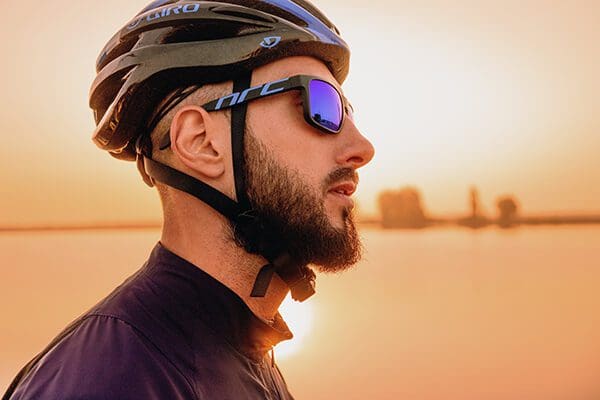
You deserve clear vision. We can help.
With 135+ locations and over 2.5 million procedures performed, our board-certified eye surgeons deliver results you can trust.
Your journey to better vision starts here.
Types of Eyewear for Sports
If you have visual issues like astigmatism, color contrast problems, ocular alignment issues, or depth perception struggles, there are ways to correct these problems as you also work with a sports vision trainer to improve your reaction times with better information about your sight.
The most common ways of correcting vision issues include:
- Glasses. If you need your color contrast, ocular alignment, or visual acuity improved, glasses are the go-to for anyone, including athletes. New types of lenses can reduce glare or reflections. They can wrap around the sides of your eyes or have thinner or clear frames for improved peripheral vision. They can also include special coatings on the lenses to get several improvements to your vision at once. There are better ways for glasses to fit on your head too, so they do not fly off during gameplay.
- Contact lenses. Although many athletes wear glasses, contact lenses are considered superior. They allow for the best possible peripheral vision and central vision at the same time, with usually about a 15 percent better visual field over glasses. Contacts provide better depth perception, so they are not only better for seeing distant balls or other players, but they are better in daily life for driving or similar tasks. There is less risk of contacts falling out and being damaged, although they can still come out at an inopportune time.
- Refractive surgery. More often, athletes are choosing refractive surgeries like laser-assisted in situ keratomileusis (LASIK) to improve their vision. Rather than wearing glasses or contact lenses, you will have no visual devices to keep track of after the procedure. Nothing will fall away from your eye or become damaged. Regular eye exams are enough to monitor your vision and eye health. Many people who undergo LASIK also get better depth perception, better contrast vision, and improved visual clarity. There is very little recovery time after LASIK. You may need to take up to two weeks off regular training regimens to ensure the eyes heal completely.
Health Resources for Athletes
Unfortunately, athletes often feel personal and professional pressure to play as many games as possible, even when sick or injured. The likelihood of losing sight from a common eye disease, eye damage, or a concussion is much higher when athletes do not know how to report these problems.
Here are some health resources for athletes of all types. If you know an athlete who is experiencing eye issues, encourage them to get treatment as soon as possible, so their long-term health does not suffer.
- NCAA Mental Health Resources
- Varsity Student-Athlete Wellness Resources
- What Is Athletic Training? The National Athletic Trainers Association (NATA)
- Olympic-Recognized Global Health Resources
- Visual Performance Assessment & Training for Athletes
You deserve clear vision. We can help.
With 135+ locations and over 2.5 million procedures performed, our board-certified eye surgeons deliver results you can trust.
Your journey to better vision starts here.
References
- Vision and Sports Performance. International Sports Vision Association (ISVA).
- Vision in Sports. Psychology, IResearchandReference.com.
- National Football League. (February 2020). Encyclopedia Britannica.
- Varsity Football Helmet Ratings. Virginia Tech Helmet Ratings.
- Eye Black Used to Cut Glare, or Turn Up Spotlight. (December 2006). The New York Times.
- Oakley Football Visor. SportsRx.
- ‘Football Vision’ as Important as Ball Skills, Experts Reveal. (September 2018). Science Daily.
- Homepage. Major League Baseball.
- The Elite Vision of Major League Baseball Players. Smart Vision Labs.
- How to Choose Sunglasses to Wear on the Diamond. Dick’s Pro Tips, Dick’s Sporting Goods.
- The 10 Best Baseball Sunglasses for 2020 | Protection & Style. Sport Consumer Gear Reviews.
- New Vision App Keeps Baseball Players’ Eye on the Ball. (July 2014). CBS News.
- Homepage. NBA.
- Madness: Basketball Is the Leading Cause of Eye Injuries. (April 2019). American Academy of Ophthalmology (AAO).
- Liberty Sport F8 Morpheus III ASTM Sports Goggles. SportsEyes.
- Homepage. NHL.
- Hilco Boston Sports Goggles. SportsEyes.
- Impact of Visors on Eye and Orbital Injuries in the National Hockey League. (June 2014). Canadian Journal of Ophthalmology.
- Sports Eye Protection History: Milestones in Athletic Safety. (April 2014). American Academy of Ophthalmology (AAO).
- Protective Eyewear Reduces Field Hockey Eye Injuries Without Increased Concussion Risk. (August 2015). Science Daily.
- Seven Best Hockey Visors (2020) – Bauer & Oakley Hockey Visors. (December 2019). HockeyPursuits.
- Tennis. (January 2020). Encyclopedia Britannica.
- Quantifying the Injury of the Human Eye Components Due to Tennis Ball Impact Using a Computational Fluid-Structure Interaction Model. (December 2015). Sports Engineering.
- Physically Speaking: Eye on the Ball. (October 2017). WTA.
- Nine Best Tennis Sunglasses 2019 Reviews [Reduce Glare and Protect Your Eyes]. Pickleball Portal.
- Sports Vision Testing. International Sports Vision Association (ISVA).
- What Are the Five Most Common Eye Injuries for Athletes? USC Roski Eye Institute, Keck Medicine of USC.
- Benefits of Contact Lenses Over Glasses in Sport. International Sports Vision Association (ISVA).
- Five Reasons Competitive Athletes Choose LASIK. (July 2016). American Refractive Surgery Council (ARSC).

As the founding partner of the Advanced Ophthalmology Institute in 1999 and the former Los Angeles (previously San Diego) Chargers’ team ophthalmologist for over a decade, Dr. Parikh knows the value of precision and the outcomes in vision enhancement surgery.
This content is for informational purposes only. It may have been reviewed by a licensed physician, but is not intended to serve as a substitute for professional medical advice. Always consult your healthcare provider with any health concerns. For more, read our Privacy Policy and Editorial Policy.
